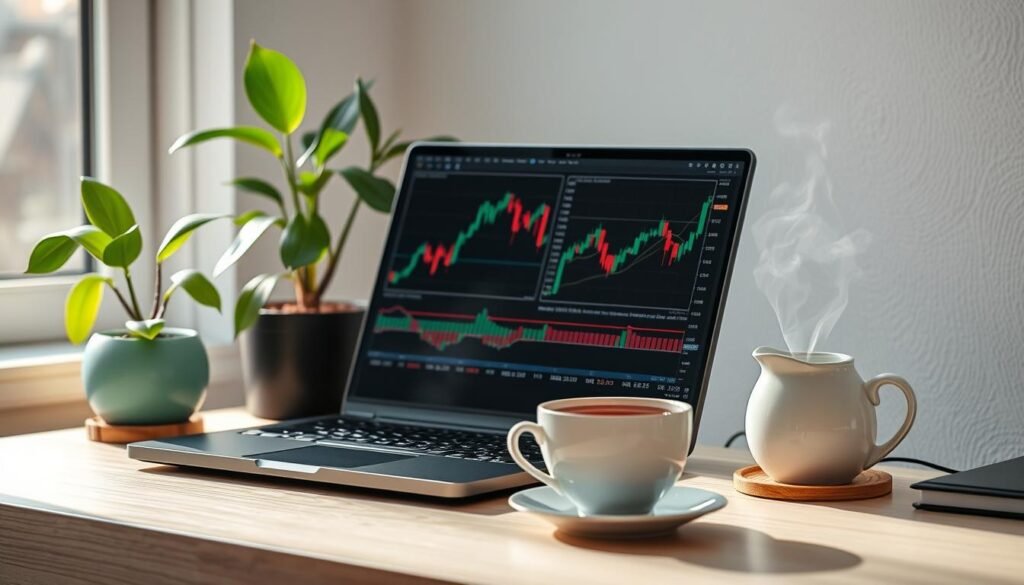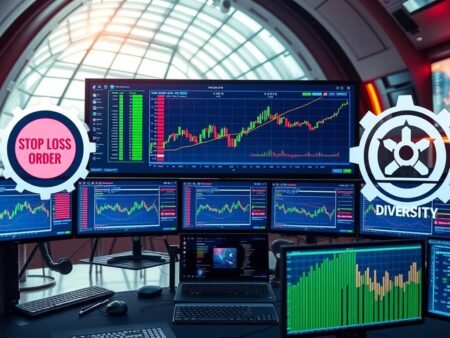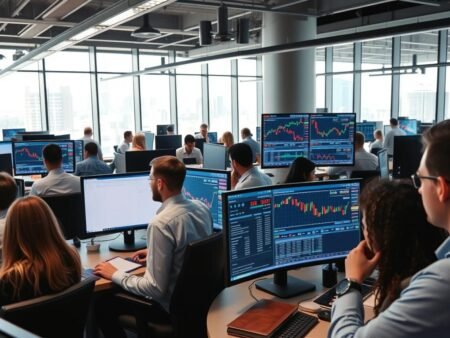Can you stay steady in the ups and downs of prop trading? This field is all about quick changes, making how to achieve consistency in Prop Firm Trading Challenges a major goal. It’s not just about spotting market trends. It’s about being dedicated and understanding your own trading mind.
Prop trading is a tough field where only the most disciplined make it. Winning once isn’t enough. You need to keep making money to succeed. We’re going to explore how to stay on top in this world of trading, focusing on Prop trading performance optimization that lasts.
We’ll look at the key to prop trading success. It’s about being precise, looking ahead, and being flexible. Come with us as we explore what it takes to keep your trading career on track.
Key Takeaways
- Insight into achieving consistent results amidst the ever-changing dynamics of prop trading.
- Exploration of techniques for Prop trading performance optimization.
- Understanding the critical role of discipline and strategy in successful prop trading.
- Discussion on the importance of risk management for long-term trading success.
- Examining best practices in adopting a trader mindset that facilitates sustained profitability.
Understanding Prop Firm Trading Challenges
Proprietary trading offers both great opportunities and tough challenges. To succeed, traders must learn specific strategies. These strategies help in making more money and growing as traders.
The Nature of Prop Trading
In proprietary trading, traders use the firm’s money to make trades. They aim to make more money than they invest. This setup gives traders big advantages like lots of capital and advanced tools.
But, it also comes with a big challenge. Traders must learn strategies that fit the firm’s risk rules and market chances.
Common Hurdles for New Prop Traders
New traders in prop firms face many obstacles. Emotional decisions are a big problem, especially when managing big amounts of money. They also struggle to learn about risk and how to trade well in changing markets.
| Challenge | Impact | Technique Recommended |
|---|---|---|
| Emotional Trading | Can lead to poor decision-making and losses | Adopt a disciplined trading plan |
| Lack of Experience | Increases the risk of significant errors | Continuous training and mentorship |
| Poor Risk Management | Direct impact on profitability | Implement advanced risk management strategies |
To succeed, traders need to understand the market well. They must also be ready through learning and practical experience in prop trading strategies.
How to Achieve Consistency in Prop Firm Trading Challenges
Proprietary trading is a world full of ups and downs. To succeed, you need to master many skills. Understanding the market and staying disciplined are key. This section will show you how to be consistent and profitable in the long run.
- Establishing a Robust Trading Plan: A good plan sets clear goals and strategies. It’s like a roadmap for traders to follow.
- Continuous Market Analysis: Keeping up with market trends is vital. Adapting your strategies helps you stay ahead.
- Performance Review and Strategy Adjustment: Regularly check your results and tweak your strategies. This keeps you in sync with the market.
Trader discipline in prop trading is crucial. It means staying calm, handling pressure well, and making precise trades, no matter what the market does.
Consistency in trading is less about individual profitable trades, and more about achieving profitable outcomes over a period of time through disciplined trading practices.
The table below shows the key factors for prop trading success. It compares disciplined traders with those who lack discipline. It highlights how important trader behavior is for success.
| Aspect | High Discipline | Low Discipline |
|---|---|---|
| Adherence to Trading Plan | Strong | Weak |
| Response to Market Volatility | Strategic | Reactive |
| Risk Management | Effective | Poor |
| Long-term Profitability | Higher | Lower |
To do well in proprietary trading, you need a focused approach. Self-regulation and adaptable strategies are key. These skills help you turn challenges into chances to make money in the competitive world of prop trading.
Fostering a Trader Mindset for Long-term Success
The key to success in trader mindset in prop trading is building important psychological traits. These traits help traders perform at their best. Having a mindset for long-term success is crucial for a long career and overcoming challenges in prop trading.
To develop the right mindset, focus on being resilient, objective, and able to stay focused under pressure. Here are key traits and practices to support these goals:
- Resilience: Recovering from setbacks without losing momentum is key. Emotional resilience protects traders from market volatility.
- Objectivity: Making trading decisions analytically helps avoid emotional biases. This is important for consistent decision-making.
- Focus: Staying focused on trading, even when stressed, prevents mistakes and distractions.
Also, continuous learning and being adaptable are crucial for staying competitive in prop trading. The trading world changes fast. Being able to adjust strategies is a sign of a seasoned trader.
“Mastering the market begins with mastering the mind.” – This principle shows how important a resilient, objective, and focused mindset is for prop trading success.
In conclusion, whether you’re new or experienced, developing these mindset traits can greatly improve your prop trading skills. It builds a strong base for meeting and exceeding the challenges of managing large trading portfolios.
Strategic Planning: Setting Up for Consistent Wins
In the world of proprietary trading, being ahead and flexible is key. A top trader knows the best strategies and can change them as the market does. This skill is vital for making money consistently in prop trading.
Identifying Profitable Trading Strategies
Choosing the right strategies is crucial for success. Traders must test and analyze many strategies to see which work best. It’s not just about finding winners, but also understanding why they work.
Adapting Strategies to Market Conditions
The markets are always changing, thanks to world events and more. Traders must adjust their strategies to keep making money. Being able to quickly change plans based on market signs is a must.
- Keep testing strategies to make sure they still work today.
- Use advanced tools to predict market changes and plan ahead.
- Try out new strategies in simulation trading before using them for real.
Always being ready to change your trading plan helps keep your money safe. It also leads to stronger and more flexible trading methods. So, always updating and improving your strategies is key to lasting success in prop trading.
Risk Management: The Cornerstone of Prop Trading
Risk management in prop trading is more than a strategy; it’s the base of all successful trading. Without a solid risk management plan, even the best strategies can lead to big losses. It’s about keeping your capital safe and making more money over time.
Successful prop trading techniques rely on strong risk management plans. These plans help traders spot, measure, and lower risks in different markets. By managing risks well, prop traders can keep making money and stay in the game for a long time.
| Risk Management Technique | Description | Impact on Prop Trading |
|---|---|---|
| Stop-Loss Orders | Automatically sell a security when its price falls to a certain level to prevent further loss. | Limits potential losses, essential for preservation of trading capital. |
| Diversification | Spreading investment across various financial instruments to reduce risk. | Minimizes the impact of poor performance of any single investment. |
| Risk/Reward Ratio | Assessing the potential reward of a trade relative to its risk. | Encourages more thoughtful trades with higher likelihood of profitability. |
| Position Sizing | Controlling the amount invested in a particular trade according to its perceived risk. | Prevents over-exposure and helps maintain an even keel in portfolio fluctuation. |
Risk management in prop trading is not just theory; it’s daily practice. These methods are key for any trader wanting to succeed in proprietary trading. They mix market knowledge with analytical skills.

The role of risk management in prop trading is huge. It’s a key part that supports all trading aspects, helping traders make smart choices for their financial future. Mastering risk management means traders can handle even the toughest markets with confidence.
Trader Discipline: Staying the Course Amidst Volatility
Understanding trader discipline in prop trading is key to success in financial markets. It’s not just helpful; it’s essential. Traders who stay disciplined can stick to their strategies and keep their emotions in check. This is crucial for making money in the long run.
Choosing the right prop firm is vital for disciplined trading. It’s important to have clear rules and stick to them. This is the foundation of disciplined trading.
Establishing Trading Rules
Creating clear guidelines is the first step in prop trading. These rules include how to enter and exit trades, and how to manage risks. Without these, traders might make decisions based on emotions, not strategy.
Maintaining Discipline During Trades
Keeping discipline during trades is hard, especially when markets are unpredictable. Traders need to prepare before trading, keep learning, and control their emotions. Sticking to your plan, even when markets change, helps you make decisions based on your goals, not just the moment.
Here’s how disciplined prop traders handle different market scenarios:
| Scenario | Action Based on Rules | Discipline Required |
|---|---|---|
| Unexpected market dip | Apply risk management strategy | Resist the urge to ‘panic sell’ |
| Surge in market | Evaluate if surge aligns with analysis | Avoid ‘fear of missing out’ buying |
| Stagnant market conditions | Stick to the pre-defined trading plan | Maintain patience and avoid overtrading |
In conclusion, trader discipline in prop trading is about following rules, no matter what. It’s a key to success, helping traders trade wisely and steadily. This discipline is essential for a stable and thoughtful trading approach with a prop firm’s capital.
Implementing Successful Prop Trading Techniques
To succeed in proprietary trading, you need to use careful techniques and strategies. This part will look at how technical and fundamental analysis help improve prop trading strategies.
Technical Analysis and Its Importance
Technical analysis in prop trading is key for spotting market trends and predicting future prices. By studying charts and using indicators, traders can find the best times to buy and sell. This makes their trading decisions better and can lead to more consistent profits.
Being able to understand price changes, volume, and past data helps traders make smarter trades. This reduces risks and keeps up with the fast changes in markets. It makes trading strategies stronger and more flexible.
Fundamental Analysis in Prop Trading
Fundamental analysis in prop trading looks at economic signs, market mood, and financial reports to guess long-term price changes. Knowing the big picture helps traders see how big events might affect markets.
| Analysis Type | Focus Area | Benefits in Prop Trading |
|---|---|---|
| Technical Analysis | Price Patterns, Trends | Identifies entry and exit points, helps in short-term strategies |
| Fundamental Analysis | Economic Indicators, Financial Statements | Assists in understanding long-term market trends and underlying values |
Using both types of analysis makes prop trading strategies more detailed and accurate. It gives a full view that leads to smart, profitable trading choices.
Critical Analysis of Trader Performance
To keep succeeding in prop trading, it’s key to analyze your trading performance closely. This part talks about how traders can use important metrics and feedback to boost Performance optimization in prop trading. The goal is to make strategies better and improve how you make decisions, which are key factors for prop trading success.
Knowing your trading metrics and checking them often helps you see what you’re doing well and what needs work. It’s not just about winning or losing. It’s about the quality and consistency of your trades that help build a successful trading career.
- Regular performance reviews
- Adaptation of strategies based on analytical results
- Feedback mechanisms to support trading decisions
Table: Key Trading Metrics
| Metric | Description | Importance |
|---|---|---|
| Win Rate | Percentage of trades that are profitable | Indicates the effectiveness of trading strategies |
| Risk/Reward Ratio | Comparative metric of potential risk to potential gains | Helps in balancing the profitability with risk levels |
| Drawdown | Largest drop from a peak to a trough of a portfolio, before a new peak is attained | Measures the risk of a specific strategy |
| Sharpe Ratio | Measure of risk-adjusted return | Assesses the performance of an investment compared to a risk-free asset, after adjusting for its risk |
The analysis above, focusing on key factors for prop trading success, is crucial for any trader aiming for performance optimization in prop trading. By adopting these practices, you’ll not only improve your trading right away. You’ll also set yourself up for long-term success and consistency in the fast-changing world of prop trading.
Building Consistent Profitability in Prop Trading
Consistent profitability in prop trading depends on managing expectations and profits well. It also requires strong scaling strategies. Let’s explore these key points to see how traders can grow and stay profitable in prop trading.
Managing Expectations and Profits
Keeping a realistic view is key for long-term success in prop trading. Traders should know that big profits come with big risks. Smart profit management, like reinvesting and saving enough, helps keep things stable and grows your wealth over time.
It’s also important to regularly check your financial goals and adjust your strategies as the market changes. This proactive approach helps protect against market ups and downs, keeping your profits steady.
Scale and Growth in Prop Trading
Scaling up in prop trading needs a balance between risk and reward. Increasing trade sizes or exploring new markets should be well-researched. Understanding the impact on your portfolio is crucial.
Using advanced analytics can help make these decisions. It helps find the best times to grow without taking too much risk.
| Year | Profit Margin (%) | Market Expansion |
|---|---|---|
| 2021 | 15 | Domestic |
| 2022 | 25 | International |
| 2023 | 35 | Global |
Growth must be matched by continuous learning and adapting. As traders learn more about different markets, they can better manage growth. This helps them stick to a disciplined trading plan for steady profits in prop trading.
Overcoming Psychological Challenges in Prop Trading
To succeed in prop trading, it’s as important to tackle psychological hurdles as it is to improve trading skills. A strong trader mindset in prop trading requires effective ways to handle market risks and personal stress. These factors can greatly affect performance.
Dealing with Losses
Losses in prop trading are a normal part of the game. They test a trader’s mental strength. It’s crucial to see losses as chances to learn and grow.
Traders should look at each loss as a lesson. This can teach them about market behavior, risk management, and their own strategies. This approach helps build a stronger trader mindset.
Stress Management Techniques for Traders
Effective stress management in prop trading involves creating routines and strategies. These help keep mental clarity and decision-making sharp, even when under pressure. Here are some practical methods traders can use:
- Regular physical exercise to reduce tension
- Meditation and deep-breathing exercises to enhance focus
- Setting realistic trading goals to avoid undue pressure
- Keeping a trading journal to reflect on both successful and unsuccessful trades
Also, regularly checking personal stress triggers and responses helps traders stay at their best.
| Technique | Benefits | Frequency | Duration |
|---|---|---|---|
| Meditation | Increases mental clarity, lowers stress levels | Daily | 20 minutes |
| Physical Exercise | Enhances physical health, improves emotional resilience | 3-5 times a week | 30-60 minutes |
| Trading Journal | Promotes reflective learning, boosts decision-making confidence | After each trading session | Varies |

Leveraging Technology for Enhanced Prop Trading Performance
The world of proprietary trading is changing fast. Technology in prop trading is now key for better performance. Traders and firms use advanced tools and algorithms to make smarter choices and get better results.
One big change is the new trading platforms. They offer real-time data analysis, which is vital for quick, smart trading decisions. These platforms have automated trading, risk management tools, and predictive analytics. They all help improve trading performance a lot.
- Automated Trading Systems: These let traders make trades at the best prices, based on set rules. This reduces the emotional and guessing parts of trading.
- Risk Management Software: It helps spot, analyze, and reduce risks. This leads to more steady returns.
- Predictive Analytics: It uses past data and AI to predict market trends. This helps traders plan their moves before they happen.
Using technology in prop trading makes trading more efficient and accurate. It lets traders handle many accounts and strategies well. This leads to better overall prop trading performance optimization.
In the fast-paced world of prop trading, staying on top means using new tech. It’s not just about having the best tools. It’s also about knowing how to use them well to stay ahead and get consistent trading results.
Cultivating Patience and Resilience in Trading
Patience and resilience are key for trader discipline in prop trading. They help traders overcome challenges in prop trading and stick to strategies for long-term success. By understanding and using these traits, traders can handle the ups and downs of prop trading.
Building these qualities helps traders grow and make money over time. It’s about staying focused and adjusting to new info. This mix is what makes traders successful in a tough market.
- Patient traders wait for the best trades, avoiding bad ones.
- Resilient traders bounce back from losses, using them to improve.
Trader discipline is very important in prop trading. It makes sure traders make decisions based on a solid plan, not just market conditions.
| Quality | Benefits | Impact on Trading Discipline |
|---|---|---|
| Patience | Allows proper timing and better decision-making | Reduces impulse trades, increases strategy adherence |
| Resilience | Facilitates recovery from losses | Encourages consistency, learning from mistakes |
Improving patience and resilience takes dedication and a clear trading plan. Focusing on the process, not just results, helps in overcoming challenges in prop trading. This mindset is key for dealing with trading’s highs and lows.
The path to mastering trader discipline in prop trading never ends. Patience and resilience are essential, not just traits. As traders work on these, they pave the way to success in the fast-paced world of prop trading.
Importance of Continuous Learning in Prop Trading
In the fast-paced world of prop trading, continuous learning in prop trading is not just beneficial; it’s essential for long-term success. Traders must constantly evolve their strategies and knowledge to stay relevant and profitable. This ongoing education involves both staying updated with the latest market trends and comprehensively analyzing past trading performances.
Staying Up-to-Date with Market Trends
For a prop trader, adapting to market trends is critical. This means keeping a vigilant eye on global economic events, market news, and technological advancements. Such information can lead to predictive insights, enabling traders to adjust their strategies in real-time to mitigate risks and capitalize on opportunities.
Learning from Trading Mistakes
Mistakes are inevitable in the journey of a prop trader, but the key differentiator between success and failure often lies in one’s ability to learn from these errors. Analyzing what went wrong and making calculated adjustments prevents future occurrences of the same mistakes, thereby refining the trader’s approach and enhancing their tactical acuity.
Through both adapting to market trends and learning from past errors, continuous learning in prop trading empowers professionals to not only improve their skills but also to sustain profitability and growth in the ever-changing market landscape.
Key Factors for Prop Trading Success
Success in proprietary trading is not just about skill. It also depends on strategic principles. These principles are key to key factors for prop trading success. They help traders manage capital, risk, and their own psychology. Let’s explore these elements to grasp the essence of successful prop trading techniques.
Managing capital well is vital. It lets traders keep operations running and grab market chances without running out of funds. Deep market analysis is also crucial for making smart trading choices. Good risk control protects against losses, keeping a trader’s career alive. Lastly, staying mentally tough helps traders stick to their plans, even when markets are unpredictable and emotions are high.
- Comprehensive market analysis
- Strategic risk management
- Rigorous capital management
- Psychological resilience
These key factors for prop trading success are more than just about money or market knowledge. They also involve managing oneself. This all-encompassing strategy sets apart successful prop traders from others.
Success in proprietary trading is achieved through a blend of knowledge, discipline, and mental fortitude.
| Factor | Description | Impact on Trading Success |
|---|---|---|
| Capital Management | Effective allocation and preservation of capital. | Ensures operational longevity and ability to capitalize on trades. |
| Market Analysis | Detailed examination of market conditions and trends. | Enhances decision-making accuracy. |
| Risk Management | Identification and mitigation of financial risks. | Protects against large losses and promotes steadier returns. |
| Psychological Resilience | Maintaining focus and composure under pressure. | Critical for long-term consistency and stress management. |
Grasping these key factors for prop trading success gives traders a blueprint for successful prop trading techniques. This blueprint leads to lasting profits and growth in the competitive world of proprietary trading.
Networking and Community: Learning from Other Prop Traders
In the world of prop trading, Networking in prop trading and Community engagement in prop trading are key. They help traders grow and do better. By talking with others and sharing ideas, traders can learn new strategies and improve their own. They can also find great partners.
Engaging in Trading Forums
Trading forums are great places for traders to meet and share. Here, everyone can learn from each other. It’s a place where you can always get better.
Being part of these forums keeps traders up-to-date. They learn about new trends, rules, and tech. This helps them stay ahead in the fast world of trading.
Seeking Mentorship and Collaboration
Mentorship is a big part of prop trading networking. More experienced traders help new ones. They teach them how to avoid mistakes and learn the markets.
Working together, traders can come up with new ideas. This teamwork helps everyone grow. It also makes trading better for everyone.
| Benefit | Detail |
|---|---|
| Exchange of Ideas | Traders share and critique strategies, enhancing their effectiveness and applicability. |
| Learning from Mistakes | Open discussions about trading errors prevent future errors and refine risk management techniques. |
| Technological Advancement | Exposure to new tools and platforms that can automate or enhance trading operations. |
| Mutual Support | Building relationships that provide emotional and motivational support during tough trading periods. |
In summary, networking in prop trading and community engagement in prop trading are more than just making friends. They are about being part of a community that helps everyone get better and succeed.
Performance Optimization: Reviewing and Improving Strategies
In the world of proprietary trading, staying ahead is crucial. Traders must always be looking to improve their strategies. They do this by reviewing past trades and learning from them.
They also use insights from proprietary trading firm resources. These resources share experiences and analyses that help refine strategies.
Improving strategies goes beyond just looking at past trades. It involves studying market trends and learning to adapt quickly. By constantly refining their strategies, traders can find new opportunities and improve their skills.
This process helps traders become better at analyzing markets. It’s a key part of success in this fast-changing field.
The drive for improvement creates a culture of excellence in prop trading. It means staying up-to-date with the market and preparing for the future. By improving their methods and managing risks well, traders can achieve consistent success.












